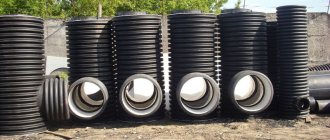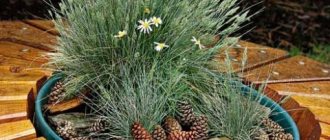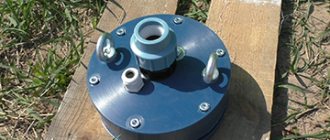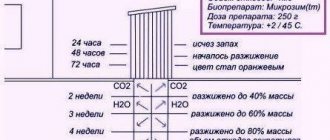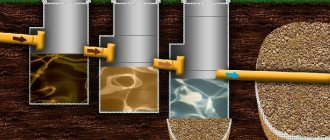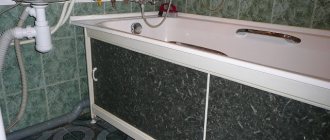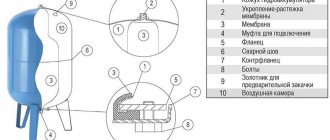The water in the well should always be clean, not freeze in winter, and remain cool in summer. To do this, the well shaft is covered with a lid. It can be solid or double - with the presence of a main open part and a closing hatch. In any case, the design is not difficult to manufacture independently. A do-it-yourself well cover is most often made of wood, metal, plastic, and concrete. We invite you to familiarize yourself with the most important characteristics of a reliable well cover, as well as with the manufacturing technology of several similar “models”.
The well cover must be strong and durable. In addition, it is desirable that it “suits” the style of the well and fits into the garden design
Why do you need a well cover?
The water in the well is purified slowly because it is not running. Various unwanted microorganisms can settle in it, and under the influence of sunlight a favorable environment will be created for their reproduction. Ultraviolet light also promotes the spread of algae and water blooms.
In addition, before making a cover for a well, you need to take care of the safety of children who, having played too much, may not notice it and stumble if it does not protrude much above the surface. Even the high above-ground part is not an obstacle to children's curiosity.
You should also take care of the possibility of insulating the lid for the winter or for preservation. And, of course, an important function is decorative. A simple concrete circle among the greenery of the lawn looks very unsightly.
Manhole sizes and cover diameters
Sewer hatches are distinguished by load class:
- Light, small-sized hatches are suitable for pedestrian areas of private territory. Marking according to EN-124 – LM (A15). Load of at least 15 kilonewtons (1 ton = 10 kilonewtons). Product weight 45 kg.
- Light but more massive products weighing up to 60 kg are installed in pedestrian areas of public places. The rated load is also 15 kN. Marking – A15 L.
- The average hatch has a safety factor of up to 125 kN and weighs 95 kg. Recommended for parking lots, sidewalks, park areas. Marking C (B125).
- Heavy sewer manholes are used on routes with heavy traffic flow. The hatch weight is 120 kg, and the rated load is 250 kN. Designation – T (C250).
- Heavy main hatches can withstand a load of 400 kN and weigh 140 kg. They are used on intercity highways, where, in addition to passenger cars, trucks and buses operate. TM marking (D400).
- Extra-heavy sewer hatches are used in the construction of airfields and docks, where the weight of transport exceeds 100 - 200 tons. Loads over 600 kN with a product weight of 155 kg. Marking – ST (E600).
In the designs of heavy and super-heavy products, elements that cause load concentration at one point and provoke metal fracture are excluded. Such hatches are made on machines with numerical software, which ensures a tight fit of the cover to the body, eliminating uneven loads during impact.
The larger the size of the body and covers, the more load the product can withstand.
| Name | Housing – dimensions in mm (manhole diameter/height) | Cover – dimensions in mm (diameter/height) |
| Lightweight, compact, less than 1 t | 720/60 | 600/25 |
| Lightweight less than 2 tons | 750/90 | 690/55 |
| Lightweight less than 5 tons | 750/90 | 690/55 |
| Average less than 5 tons | 750/100 | 690/50 |
| Heavy less than 25 t | 800/110 | 700/70 |
| Square less than 2 t | 640/640 | 600/600 |
These dimensions refer to standard cast iron structures. Although the industry produces hatches of different sizes. You can find a very small one - with a diameter of 38 cm - cast iron, and a polymer one measuring 1 m.
Materials for well cover
When thinking about how to make a cover for a well with your own hands, the thought of buying a finished product often comes up. The idea is certainly not a bad one, but if there are construction remains on the site, you can use them too.
Tree
You can make a simple circle of thick boards or decorate the landscape with a small architectural form.
Before you make a cover for a well from wood with your own hands, you need to correctly calculate your own strengths and skills. For example, knocking down several boards and cutting them into a circle is one thing, but creating an intricate house is another.
Plastic
If the question arises of how to make a cover for a well from concrete rings, then it is easier to buy one. In the plastic segment there is room to roam, it could be:
- A round, flat hatch with a slight slope and a ribbed inner surface. Products are produced with a diameter of 35-120 cm.
- Plastic lid with lock. This model is convenient in cases of non-permanent residence in private property.
- Decorative element. Such covers are made in various decorative options - to resemble a stone, a stump, or a flower meadow. Due to the lightness of the products, additional fixation is required.
When choosing a plastic lid, you should pay attention to the presence of a handle, external grooves and hooks. To extend the service life, it is better to varnish the outside of the lid.
Plastic product for a well made of reinforced concrete rings Source market-abs.ru
See also: Catalog of companies that specialize in heating, water supply and septic tanks
Polymer-sand hatch
Such models are designed for composite or reinforced concrete septic tanks. They have a completely aesthetic appearance, light weight, low price, are presented in a wide color palette, and can be square or round in shape.
Square polymer-sand hatch Source krov-m.ru
Option #1 – simple wooden lid
A decorative cover for a wooden well can be made independently; the manufacturing process is quite simple. For the lid you need to choose durable wood - elm or aspen will do. You can also use pine, but the wood of this tree is softer. The size and shape of the product are determined according to the type of structure and neck of the well.
The easiest way is to make a cover in the form of a hatch. For making, you will need nails, hinges, measuring tools, dry boards with grooves, handles, hinges, six bars (20-30 cm for one cover), a hacksaw, a thick rubber belt, screwdrivers, and a hammer.
It is better to make a double wooden lid. This is done so that it does not freeze in winter. You can make a hinged or removable cover - which one it will be will be determined when drawing up a work plan.
The hinged lid for the well with a comfortable wooden handle is practical and easy to make. Hinges and a carved handle give the simple design a decorative look
The work begins with the installation of the lathing and the necessary measurements. In order for the hatch to be firmly located in the neck, it is necessary to make a lath. It is made from bars according to the size of the neck. To cover the structure, you can use tes. Metal hinges are attached to it. The hinges can be replaced with a rubber belt - one end of it is nailed to the lid, the other to the trigger.
The simplest option for a well cover is timber sheathing and wooden boards. In cold winter conditions, it is recommended to make two such covers and lay insulation between them, this will help the water not to freeze
The main functions of the second sash (if you choose this option) are additional protection and bridging gaps, if any. For strength, the lid is reinforced in the center from below with timber. A pair of identical covers is made - lower and upper. The lower one is installed in the lower part of the neck, the upper one in the upper part. In winter, a straw cushion is placed between them for insulation. If in your region the temperature in winter drops to -20 degrees or more, a double lid is required - otherwise the water will freeze.
The simplest handles for a wooden lid are bars stuffed parallel to each other. But for greater convenience and aesthetics, you can use ready-made wooden or metal handles. As for the castle, this is a matter of personal choice. Some people use shut-off devices to make the well more secure when the owners are away.
After making the lid, you can think about how to decorate the well. There are two traditional options: make a decorative house on poles or install a flat roof of a round or rectangular shape. The roof can be gable in the shape of a house, flat, round, sloping - at your discretion. You can use various materials to decorate it - natural and bitumen tiles, metal tiles, vines and vines, straw, boards, slate, carved decor, etc.
Recent Entries
5 working ways to use tar in the garden 7 indoor plants that help you get married even in adulthood Indoor plants that can bloom in trouble
Well house
Before you make a cover for a well with your own hands from wood in the form of a house, you should create a drawing indicating the dimensions so that you can already prepare the required amount of materials from it. For a simple design you will need:
- 2 end posts made of timber with a cross-section of 8 cm;
- 4 bars for the base frame;
- 4 bars for rafters and 1 for ridge;
- 3 bars for forming the door;
- 3-4 pieces of durable board for installation on a round well and for a bucket.
The frame is assembled from all materials.
All that remains is to sheathe it and make the door on hinges. If the house is located high from the ground, then it makes sense to make a gate.
The finished house can be placed on the ground or on a concrete well Source kolodecrussia.ru
The structure can be sheathed with soft tiles or other waterproofing material. You should not make the roof too heavy to avoid the structure from skewing after a couple of years.
The process of assembling a well hatch with your own hands
Several step-by-step instructions for making simple hatches for a well from wood and iron. If metal is used, composite textolite will be additionally used for cladding.
Made of metal and textolite
The process of all work step by step:
- Metal corners are taken and cut to the required size. Based on the dimensions of the well, proportionality is maintained.
- A 45° cut should be made from the end of the corner on the bottom shelf.
- There should be 4 of these blanks of the same size.
- All elements are welded together to form a square. Tacks should be placed on all sides.
- Each welding seam is ground with a grinder and a special grinding disc.
- You should end up with a frame that doesn't move.
- A movable cover will be attached to the frame. It can be made from a profile pipe of rectangular cross-section.
- The length of the pipe should be 10 mm shorter in comparison with the corners. This is necessary so that the future lid can close/open freely. You should also consider the location of the hinges. To achieve perfect accuracy, it is best to prepare a diagram and indicate on it all the dimensions of each element.
- To make the frame structure strong, pipes can be cross-welded inside it.
- After this, all welds are similarly ground/cleaned.
- Next, you need to take a textolite plate and cut it out to the appropriate size for the hatch.
- Extruded polystyrene foam, polystyrene foam or other heat-insulating material can be placed in the middle between two layers of textolite.
- Next, the lower part of the structure must be secured to the head of the well. This work can be done in different ways. For example, hammer in anchors and weld a metal frame to them. Install the wooden base and secure the lid to it.
- To ensure that the inside of the frame has the same round shape, a strip is welded. Thus, formwork is obtained at the corners of the structure. These voids can be filled with concrete or also covered with textolite on both sides, and the inside filled with insulation.
- At the final stage, all that remains is to paint the entire structure in the desired color.
Insulating a well for the winter
If the well shaft is deep enough (well below the freezing point of the soil) and made of wood, then such a structure is not afraid of frost. Concrete structures with high thermal conductivity in the middle zone and to the north should be insulated.
Moreover, this must be done regardless of whether the well is used in winter or not. In the latter case, an ice plug may form, which can displace or rupture the joints of the rings, since, as we know, water expands when it freezes. Repair is an expensive undertaking.
Foam insulation
Before insulating a well made of concrete rings for the winter, you should choose the most suitable material. If insulation was not carried out at the stage of constructing the well, then this is done during operation. Before you insulate a well made of concrete rings with your own hands using polystyrene foam, you need to:
- dig around it from all sides and remove the soil;
- clean the surface from dirt;
- glue semicircular polystyrene foam; you can additionally “plant” the material on special dowels;
- cover with vapor barrier material;
- Fill with excavated soil, tamping well.
Along with such advantages as thermal conductivity, water resistance and low cost, polystyrene foam can be damaged by rodents.
Construction of wells
A sewer hatch is a product consisting of a body and a cover. Both are made of the same material.
They produce locking and non-locking structures. The first ones are installed where there is access to various expensive equipment inside the mine and there is a high probability of intentional damage or theft.
The shape of the wells can be round, rectangular or square. In most cases, round sewer manholes are used, as they are the most practical and economical.
There is a hole in the lid. It is used for opening with special hooks or for monitoring, for example, gas leaks in a gas pipeline.
The lid itself is made slightly convex so that water does not accumulate in it and does not freeze in winter. The relief is necessary so that car wheels or passers-by do not slip on the metal.
There is a special marking to determine the communications to which it leads:
- TS – heating main;
- T – telephone cable, varieties – GTS and MTS;
- MG – main gas pipeline pipes;
- GS – gas network;
- PG or G – fire hydrant;
- K – domestic wastewater (sewerage);
- B – water supply;
- D – drainage or rainwater drainage.
Hatches are marked on top with letters or drawings. For example, access to an electrical cable may be indicated by a lightning bolt.
Existing types
Any well cover is a standardized product that corresponds to the established dimensions. The structural parameters of the element are determined by the purpose and characteristics of the vertical shaft of the mine. The outer shape can be square/round, the inner hole can also be rectangular, round, square, offset round or two.
The ends can be smooth or with a rebated profile (under the ring where the manhole cover is installed), intended for mounting a rectangular grate for drainage. The load capacity of the cover is determined by the scope of application - the products are concrete and reinforced concrete (more durable due to reinforcement).
Dimensions and weight correspond to the parameters according to GOST; they can be found in special tables or checked with the manufacturer or seller.
